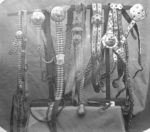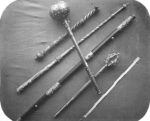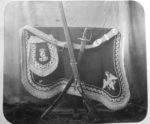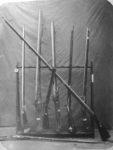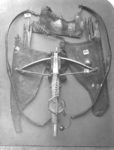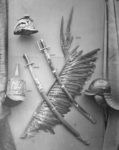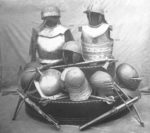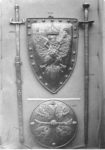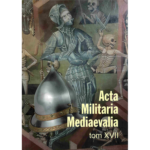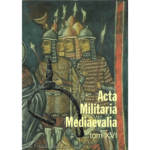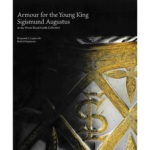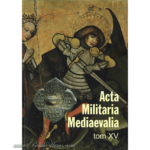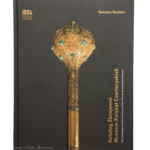
Exhibition of antiquities in 1858
EXHIBITION OF ANTIQUITIES in 1858
in Krakow
In 1858 an exhibition was organized in Krakow, todays Poland, which was probably the biggest display of historical objects in the history of Polish museology.
In 1858 Poland was still partitioned between three empires: Austria, Russia and Prussia. In Krakow, which was falling economically and prestigiously from its former glory, the memory of old and powerful kingdom and Polish language were still much alive. Having an example from Warsaw experience of 1856, Krakow’s Scientific Society decided to give a proclamation calling on the public to arrange a great exhibition devoted to Polish history and its lands. In Warsaw the same idea resulted in great exhibition of over 1000 historical objects, therefore Krakow organizers wanted to replicated the same success.
After few weeks of preparations the exhibition was opened in a private city house of prince Lubomirski, occupying few of its rooms, but the amount of objects that were still coming and coming forced organizers to take the entire building just few months after the opening. The number of objects has been calculated at over 1500. This alive and constantly changing exhibition, showed great amount of archaeological foundings, art of Polish craftsman and also a number of old arms and armour.
The catalogue was never printed which is a great shame and certain loss for our knowlegde. Even if the description of the objects were mostly based on family traditions, closer to romantic view of the history than to scientific approach, we could still find more about some of the pieces that are now in museum collections.
Nevertheless, Karol Beyer, Warsaw photographer, came to Krakow and made several pictures which were printed in album showing the highlights of the Krakow exhibition and giving us some idea of how it looked like.
The whole book made by Karol Beyer you can download from here:
Below you can selection of military objects, with translation of original captions. Please remember that dating or naming the object in 1858 was very often biased by legends and family traditions. Therefore some “pre Christian” archaeological findings could be medieval in fact, some 16th sabres could be much later, and so on…
- Objects from pre-Christian times
- 198. Two maces of weavers guild. – 246. Mace of carpenters guild. – 689. Two maces of potter makers guild. – 738. Two maces of carpenters guild. – 741. Two maces of masters of the butchers guild. – 742. Mace of butchers guild’ apprientice. – 752. Mace of the textile guild. – 836. Mace of smith guild.
- 110. Horse tack made of silver, gilded, decorated with garnets, from the coll. of Count Jan Stadnicki in Boratyn. – 1091. Horse tack made of silver, gilded, after king Stephen Bathory. Decorated with mother of pearl and green velvet, from the coll. of count Maurycy Potocki in Zator.
- 31. Staff of the Great Marshal of the Crown, fitted with gold and enameled, bearing state coat-of-arms and cypher of Jan III Sobieski. From the coll. of prince Władysław Czartoryski. – 176. Mace made of silver, gilded, decorated with stones, after hetman Stanisław Jabłonowski. Coll. of prince Adam Sapieha. – 519. Silver bulawa-mace, gilded set with turquoise and rubies, after Jan Tarnowski, coll. of Jan Tarnowski. – 2635. Sceptre made of narwhale tooth, after king Stanisław Leszczyński, from the coll. of Count Jan Działyński in Gołuchowo. – 2636. Ivory sceptre after August II (coll. as previous).
- 31. Ebony staff of the Grand Crown Marshal with coats of arms of Poland and Lithuania and the cypher of King John III (coll. of price Władysław Czartoryski). – 108. Chest containg gilded cartridge pouch, two belts (golden and silver), precious buttons and buckles (coll. of count Jan Stadnicki from Boratyń). – 113. Gilded karabela sabre made in 1607. – 987 Handle of fittings made of silver, set with stones, belonging to sabre after Jan III Sobieski (from the coll. of the late Konstanty Świdziński)
- 60. Horn with a symbol of lizard and bow (coll. of count Piotr Moszyński). – 81. Polish sash (coll. of Henryk Kieszkowski from Tarnawa). – 125, 126. Two officers’ gorgets from the times of Saxon Electors (coll. of count Jan Stadnicki). – 211. Gorget plate with depiction of Holy Mary and Christ and poems dedicated to Michal of confederacy of bar (coll. of Władysław Syrokomla). – 751. Staff of textile makers guild. – 1094. Flag point with king’s Stanisław August cypher, set with stones (coll. of count Potocki from Zator)
- 1095. Cartridge pouch belt made of silver after price Józef Poniatowski. – 1096. Sabre after Józef Poniatowski with which he drowned in Estera river. – 1097. Shotgun made for king Stanisław August by Kownacki in Warsaw. – 1143. Horse caparison after price Józef Poniatowski
- 2508. Silver, gilded mace set with turquoises. – 2514. Knife combines with pistol made in Italy. – 2516. Plate from estoc hilt plate from. – 2517a. Marshall staff, set with mother of pearl. – 2517b. Marshall staff with Lithuanian coat-of-arms and “A. R.” cypher, made of ebony. – 2518. Great ceremonial sword from 17th c. (objects from the Kórnik collection of count Tytus Działyński)
- 75. Flintolock pistol decorated with ivory, 17th. c. (coll. of count Piotr Moszyński). – 419. Sword, which according to legend, S. Zborowski was beheaded (coll. of Jagiellonian Library). -538. Flintlock pistol decorated with ivory (coll. of Karol Rogawski). – 553. Sword from 14th c. (coll. of Karol Rogawski). – 554. Hunting spear made in Rzeszów in 1739 (Karol Rogawski collection). – 740. Ceremonial sword given by the king John Casimir to butchers guild in Krakow.
- 88. Axe combined with flintlock gun (coll. of count Xawery Zamojski). – 214. Blunderbuss with “TANDEM” inscription (coll. of count Adam Potocki). – 538. Flintlock pistol set with ivory (Karol Rogawski coll.). – 539. Flintlock gun set with ivory, made in 1627 (K. Rogawski coll.). – 541. Small blunderbuss, set with ivory (K.Rogawski coll.). – 546. Deer horn for gun powder (K. Rogawski coll.). – 706. Oriental iron axe (coll. of Wincenty Kirchmajer). – 1198. Powder horn fitted with silver (coll. of count Maurycy Potocki from Zator).
- 2149. Huge wall-gun with sculpture on a barrell. – 2151. Turkish gun. – 2164. Gun with hammer set on lock mounted inversely. – 2166. Wall-gun from the end of the 17th c. – 2167. Four elbows long gun with inscription “SIGISMUNDUS REX POLONIE”, made in 16th c., converted to flintlock. – 2168. Flintolock wall-gun, 16th c. – 2169. Italian flintlock gun, made entirely of iron. – 2191. Flintlock blunderbuss made by M. Koyłak, 18th c. (objects from the armoury of Prince Jerzy Lubomirski in Przeworsk and Kraków).
- 2139. Flintlock turkish gun, set with brass. – 2140. Flintlock gun set with ivory, early 17th c. – 2241. Flintlock gun set with ivory, early 17th c. – 2143. Flintlock gun made by Zoffel in Wisental. – 2162. Short barrell gun with folding bayonet, 18th c. – 2165. Wall-gun made by Balcer Werner in 1712. – 2180. Blunderbuss with falttened muzzle. – 2192. Turkish gun (from the armoury of Prince Jerzy Lubomirski in Przeworsk and Kraków)
- 2493. Polish karabela-sabre set with gilded silver and stones. Blade with Lithuanian coat-of-arms set with gold. 17th c. – 2495. Pallash with silver fittings, covered with shagreen leather, velvet laces with gilded thread. – 2502. Sabre with silver fittings, covered with shagreen leather. – 2508. Mace – silver, gilded, set with turquoises. – 2510. iron mace, engraved and encrusted with gold. (Objects from the coll. of count Tytus Działyński in Kórnik).
- 60. Horn with a symbol of lizard and bow and date Anno DCCCXII (coll. of count Piotr Moszyński). – 68. Karabela sabre with “S. A.” inscription reffering to king Sigismund Augustus, with his coat-of-arms and date 1549 (Piotr Moszyński collection). – 89. Karabela-sabre with Lithuanian coat-of-arms, 17th c. (coll. of count Zamojski). – 116. Karabela sabre with Ottoman blade, with silver fittings, sheath coveret with velvet (coll. of count Jan Stadnicki from Boratyń). – 1725. Karabela sabre set with chalcedonies encrusted with gold, laces modern, made of gilded threads (coll. of Florentyna Czaplicka)
- 63. Two tartar bows from 17th c. (coll. of count Piotr Moszyński). – 64. Bow-case made of leather tinted in black with gilded images in Chinese style (coll. of Piotr Moszyński). – 524. Bow-case, made of leather, fittings made of gilded bronze, bearing Leliwa coat-of-arms (coll. of count Jan Tarnowski in Dzików). – 537. Crossbow set with ivory with cranequin, bow-string, bearing Sulima coat-of-arms and date 1537 (coll. of Karol Rogawski in Ołpiny).
- 2480. Brass helmet of oriental type, with image of a hussar on one of the four cartouches. – 2481. Steel hussar helmet, with brass fittings. – 2488. Helmet of the king’s Stanisław August bodyguards. – 2491. Hussar wing made of falcon feathers, for a saddle. – 2493. Karabela sabre with golden fittings, set with stones and with Lithuanian coat-of-arms on a blade. – 2497. Karabela-sabre with silver fittings. Objects from the Kórnik collection of count Tytus Działyński
- 2569. Great two-handed sword from 15th c. – 2619. Armor made of chainmail and plates, with fittings in a shape of brass roses and lion-heads, lining made of red velvet. From the times of Jan III Sobieski. – 2621. Greaves made of steel. – 2622. Scale-armor helmet, – 2624. Chainmail of amazing oriental workmanship with gilded stars. – Chainmail helmet encrusted with gold (objects from the coll. of count Tytus Działyński in Kórnik)
- 2137. Hussars armor and helmet with a chainmail. – 2138. Crossbow set with ivory. – 2201. Small bronze cannon with inscription MAR. ANT. BALA. MDCXLVI. – 2202. Small bronze cannon (without decoration). – 2225. Axe encrusted with gold, with brass handle. – 2234. Light crossbow made of palisander wood. – 2246. Bronze mace, gilded, unusual with a hand-guard. – 2252. Quiver with arrows (objects from the coll. of Prince Jerzy Lubomirski from Przeworsk and Kraków)
- 165-168. Karacena – scale-armor with velver linen, after hetman Stanisław Jabłonowski, 17th c. coll. of Prince Adam Sapieha. – 170, 171. Horse tack and saddle, with silver and gilded fittings and stones, after Stanisław Jabłonowski (coll. of Adam Sapieha). – 176. Silver and gilded mace, set with precious stones, after Stanisław Jabłonowski (Adam Sapiega coll.). – 519. Silver and gilded mace, set with turquoise and rubies after Jan Tarnowski. – 555. field bed after king Jan III Sobieski (coll. of Karol Rogawski)
- 2482, 2483, 2485. Elements of hussars’ armors with crosses and Holy Mary made of brass, 17th c. (coll. of count Tytus Działyński from Kórnik).
- 985. Iron helmet, encrusted with gold, made in Italy in 16th c. On decoration Jagiellonian Eagle included with king’s cypher “S”. From the coll. of Konstanty Świdziński.
- 61. Steel shield, encrusted with gold, a representing the conversion of Saint Paul, made in Italy, 16th c. (from the coll. of Piotr Moszyński). – 986. Iron helmet, encrusted with gold, made in Italy in 16th c. from the coll. of Konstanty Świdziński. – Steel helmet, encrusted with copper from the 11th c. (property of Poznań Science Society).
- 2006. Cuirass from 16th c. – 2008. Hussars’ armor and gorget made of steel, decorated with brass cross on a chest, 17th c. – 2009. Scale-armor helmet with chainnail protection. – 2214. Iron closed helmet, 17th c. – 2241. Brass axe from the 18th c. – 2242. Axe combined with a flintlock gun, late 17th c. – 2248. Iron mace with inscription: NICEPHORE BOTONIATE 1678. – 2249. Mace intricately finished and ecrusted with gold, 16th c. Objects from the coll. of Prince Jerzy Lubomirski from Przewors and Kraków.
- 67. Estoc with a sheath covered with a shagreen leather, set with stones, with silver fittings (coll. of count Piotr Moszyński). – 213. Armor with French and Navarra coat-of-arms from the coll. of count Adam Potocki. – 536. Mortar with “M. W.” initials, and a date “1671” (coll. of Karol Rogawski in Ołpiny). – 1181. Halebard from the city of Tarnow.
- 2478. Steel shield, with Polish Eagle, set with brass roses, early 17th c. – 2479. Iron shield of the Teutonic Order, 15th c. – 2492. Sword of the Teutonic Order, with opework sheath, 15th c. – 2516. Estoc with iron sheath, encrusted with gold and set with stones, 16th c. From the Kórnik collection of count Tytus Działyński


